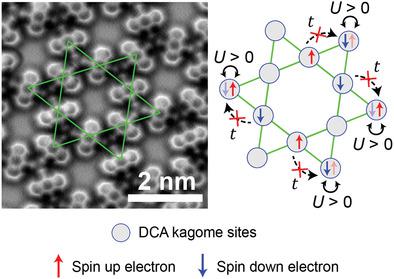当前位置:
X-MOL 学术
›
Adv. Funct. Mater.
›
论文详情
Our official English website, www.x-mol.net, welcomes your feedback! (Note: you will need to create a separate account there.)
Manifestation of Strongly Correlated Electrons in a 2D Kagome Metal–Organic Framework
Advanced Functional Materials ( IF 19.0 ) Pub Date : 2021-09-12 , DOI: 10.1002/adfm.202106474 Dhaneesh Kumar 1, 2 , Jack Hellerstedt 1, 2 , Bernard Field 1, 2 , Benjamin Lowe 1, 2 , Yuefeng Yin 1, 2, 3 , Nikhil V. Medhekar 2, 3 , Agustin Schiffrin 1, 2
Advanced Functional Materials ( IF 19.0 ) Pub Date : 2021-09-12 , DOI: 10.1002/adfm.202106474 Dhaneesh Kumar 1, 2 , Jack Hellerstedt 1, 2 , Bernard Field 1, 2 , Benjamin Lowe 1, 2 , Yuefeng Yin 1, 2, 3 , Nikhil V. Medhekar 2, 3 , Agustin Schiffrin 1, 2
Affiliation

|
2D and layered electronic materials characterized by a kagome lattice, whose valence band structure includes two Dirac bands and one flat band, can host a wide range of tunable topological and strongly correlated electronic phases. While strong electron correlations have been observed in inorganic kagome crystals, they remain elusive in organic systems, which benefit from versatile synthesis protocols via molecular self-assembly and metal-ligand coordination. Here, direct experimental evidence of local magnetic moments resulting from strong electron–electron Coulomb interactions in a 2D metal–organic framework (MOF) is reported. The latter consists of di-cyano-anthracene (DCA) molecules arranged in a kagome structure via coordination with copper (Cu) atoms on a silver surface [Ag(111)]. Temperature-dependent scanning tunneling spectroscopy reveals magnetic moments spatially confined to DCA and Cu sites of the MOF, and Kondo screened by the Ag(111) conduction electrons. By density functional theory and mean-field Hubbard modeling, it is shown that these magnetic moments are the direct consequence of strong Coulomb interactions between electrons within the kagome MOF. The findings pave the way for nanoelectronics and spintronics technologies based on controllable correlated electron phases in 2D organic materials.
中文翻译:

二维 Kagome 金属-有机框架中强相关电子的表现
以 kagome 晶格为特征的二维和层状电子材料,其价带结构包括两个狄拉克带和一个平带,可以容纳范围广泛的可调拓扑和强相关电子相。虽然在无机 Kagome 晶体中观察到强电子相关性,但它们在有机系统中仍然难以捉摸,有机系统受益于通过分子自组装和金属配体配位的多功能合成方案。在这里,报告了由二维金属 - 有机框架(MOF)中的强电子 - 电子库仑相互作用产生的局部磁矩的直接实验证据。后者由通过与银表面 [Ag(111)] 上的铜 (Cu) 原子配位而排列在 Kagome 结构中的二氰基蒽 (DCA) 分子组成。温度相关的扫描隧道光谱揭示了空间限制在 MOF 的 DCA 和 Cu 位点的磁矩,以及被 Ag(111) 传导电子屏蔽的 Kondo。通过密度泛函理论和平均场哈伯德模型,表明这些磁矩是 Kagome MOF 内电子之间强库仑相互作用的直接结果。这些发现为基于二维有机材料中可控相关电子相的纳米电子学和自旋电子学技术铺平了道路。
更新日期:2021-09-12
中文翻译:

二维 Kagome 金属-有机框架中强相关电子的表现
以 kagome 晶格为特征的二维和层状电子材料,其价带结构包括两个狄拉克带和一个平带,可以容纳范围广泛的可调拓扑和强相关电子相。虽然在无机 Kagome 晶体中观察到强电子相关性,但它们在有机系统中仍然难以捉摸,有机系统受益于通过分子自组装和金属配体配位的多功能合成方案。在这里,报告了由二维金属 - 有机框架(MOF)中的强电子 - 电子库仑相互作用产生的局部磁矩的直接实验证据。后者由通过与银表面 [Ag(111)] 上的铜 (Cu) 原子配位而排列在 Kagome 结构中的二氰基蒽 (DCA) 分子组成。温度相关的扫描隧道光谱揭示了空间限制在 MOF 的 DCA 和 Cu 位点的磁矩,以及被 Ag(111) 传导电子屏蔽的 Kondo。通过密度泛函理论和平均场哈伯德模型,表明这些磁矩是 Kagome MOF 内电子之间强库仑相互作用的直接结果。这些发现为基于二维有机材料中可控相关电子相的纳米电子学和自旋电子学技术铺平了道路。



























 京公网安备 11010802027423号
京公网安备 11010802027423号